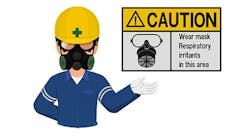Due to recent events, such as COVID-19 as well as more frequent wildfires, the National Academies of Sciences, Engineering, and Medicine recommends two frameworks for providing respiratory protection for the nation—one for workers and one for the public.
A new report, “Frameworks for Protecting Workers and the Public from Inhalation Hazards,” notes that all types of workers, including essential and gig economy workers, should be covered by OSHA or equivalent respiratory protection requirements when exposed to inhalation hazards in the workplace.
The need for such frameworks was heightened during the COVID-19 pandemic, and highlighted gaps in respiratory protection in workplaces with high airborne exposure risks, such as meatpacking, grocery stores, and restaurants. All workers need to be able to turn to a clear and authoritative source of information on respiratory hazards and how to protect themselves from current and future airborne threats, says the report.
“The COVID-19 pandemic, the threats of wildfire smoke, and mold growth from flooding have made us well aware of the dangers in the air we breathe both indoors and outdoors—and the possible harms to health,” said Jonathan Samet, dean of the Colorado School of Public Health and chair of the committee that wrote the report, in a statement. “Many workers and the American public have been asking, ‘When do I need a mask or respirator?’ ‘Which should I use?’ and ‘How do I get it?’ Having systems in place to continuously assess inhalation hazards, identify the right respiratory protective devices, and guide workers and the public on how to use them can prevent illness and save lives.”
The report recommends the U.S. Department of Labor be designated as the coordinating and responsible entity to oversee the framework for respiratory protection for workers. And says that Congress needs to revise the Occupational Health and Safety Act of 1970 to give OSHA the authority to ensure respiratory protection for workplaces that are currently outside its jurisdiction. Pending revisions to the 1970 legislation, OSHA should adopt the broadest permissible interpretation of “employees” and “employers” to expand coverage of its respiratory protection requirements. The categories of workers who could be covered under expanded definitions include gig economy workers, unpaid volunteers, domestic workers in residential settings, and some independent contractors.
In addition, the report makes recommendations to ensure a robust supply chain for respiratory protective devices, improve public health communication, and advance research on the evolving respiratory protection needs of workers.
Addressing Supply Chain Challenges
The COVID-19 pandemic exposed severe limitations in the supply chain related to respiratory protective devices. OSHA and National Institute for Occupational Safety and Health (NIOSH) should evaluate and predict the potential scope of respiratory protection needs for workers to inform stockpiling and distribution guidelines. To prevent shortages during future emergencies, OSHA should recommend appropriate quantities and types of respirators to employers.
Improving Communication, Education, and Training
Many employers may be unfamiliar with respiratory protection programs, the report says. OSHA and NIOSH should support the development of tailored guidance and training for employers and workers. OSHA should also work with labor organizations and other groups to develop tailored materials and to reach workers across different sectors.
Expanding Research and Surveillance Programs
Efforts to meet the respiratory protection needs of workers and the public must be built on a strong scientific foundation. NIOSH should expand research and surveillance programs to better understand and meet the needs of all workers, including those living with disabilities or chronic conditions. It should also prioritize research on the effectiveness of different types of respiratory protection program models. Such expanded research and surveillance activities may justify additional appropriations from Congress, the report says. Research on innovative respirator design to meet the needs of workers may also inform the development of devices intended for public use.
